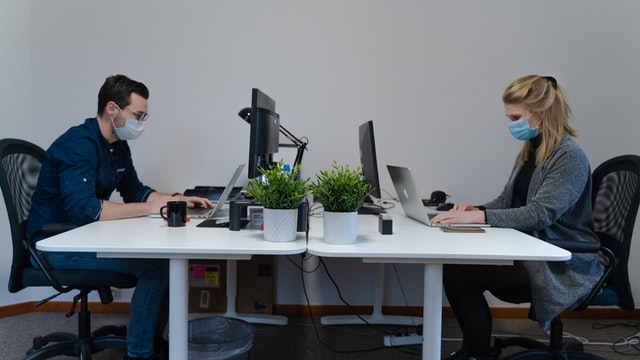You might be tired of hearing about the pandemic — but that doesn’t mean it has disappeared. The omicron variant is sweeping the nation, accounting for 73% of new infections.
If your organization has already returned to in-person operations or never abandoned them due to industry, you have a responsibility to protect your employees. Here’s how to create a safe in-person workspace during COVID-19.
1. Provide Personal Protective Equipment
There may be no realistic way for a business to identify when a worker has been exposed to COVID-19 and should quarantine. Trying to find a rapid test can prove nearly impossible in many locations. Temperature checks can’t always accurately predict whether someone is sick, as not every patient develops a fever.
Therefore, the best way to safeguard your workplace is to issue all staff members personal protective equipment (PPE). You can also encourage them to purchase supplies. Let them know that the IRS recently passed a rule allowing them to deduct the cost of masks and sanitizer on their annual tax return.
2. Establish Sanitation Stations
Depending on your industry, your workers might not be the only people entering your building. You owe it to your staff to keep them safe from outsiders bringing in germs, but you can’t rely on everyone to wash their hands.
Establish sanitation stations at all ingress and egress points if you deal with the public. Many people will voluntarily stop to sanitize their hands if they see a large dispenser at the entrance. You can also include a box of disposable masks.

3. Step Up Your Cleaning Protocols
You should improve your sanitation measures if you haven’t done so already. Fortunately, you don’t have to rely on chemical cleaners alone for banishing germs. Ultraviolet germicidal irradiation uses UV-C rays to kill COVID-19. It’s unsafe for occupied premises but safe to use after hours in shared office spaces and places like food courts where many people gather.
You should also stash disinfectant wipes for your staff to clean their workspace as often as necessary. Ensure that yours contain one of the EPA-recommended cleaners against COVID-19.
4. Maintain Your HVAC System
Addressing indoor air quality is a must amid a pandemic spread by aerosols. These germs can linger in filthy HVAC systems, sickening an entire building.
Keep up to date with your filter change schedule. It may also be helpful to get a professional duct cleaning, particularly if you occupy an older or shared building where you’re unfamiliar with the previous maintenance schedule.
5. Erect Physical Barriers
Keep your staff if they work with the public. Some grocery and convenience stores have eliminated physical barriers, but it’s smart to keep them in place while omicron rages.
Physical barriers already play vital roles in many workplaces by preventing slip and fall accidents and keeping hazardous objects from flying about and injuring people. You might not be able to see the SARS-CoV-2 virus, but it’s every bit as dangerous as a flying piece of metal.

6. Require Masks
Individual business owners maintain the right to dictate whether masks are required on-premises. Some states have prohibited schools from enacting such mandates. However, the Biden administration is investigating whether such rules violate the civil rights of students with disabilities who can’t safely return to in-person learning with uncovered peers.
You can highlight your corporate values as an organization that cares about science and human health by requiring mask use on the premises. It’s smart to keep disposables on hand for those who come in uncovered — you can deduct the expense on your taxes.
7. Allow Vulnerable Workers To Telecommute
Some staff members have medical conditions that make it downright dangerous for them to return to in-person work during a pandemic. The heartbreak of the U.S. health care system leaves many such individuals caught in an impossible catch-22. Reporting to the office can be a death sentence, but so can losing their employer-sponsored health insurance.
Make reasonable accommodations for such workers by allowing them to telecommute. The return you’ll reap in employee loyalty far supersedes the minor inconvenience of not being able to look over workers’ shoulders.
Refusing such accommodations may be ruled discriminatory depending on your industry. However, there’s a deeper moral concern. Can you sleep at night knowing you let an otherwise valued staff member go when they needed their job and coverage the most because you couldn’t show a little compassion toward their physical disability?
Create A Safe In-Person Workspace During COVID-19
After two long years, nearly everyone is tired of living through the pandemic. It’s natural to crave a return to normalcy, but it’s vital to protect the lifeblood of your organization — your staff. Consider implementing these seven tips to create a safe, in-person workspace during COVID-19.

































